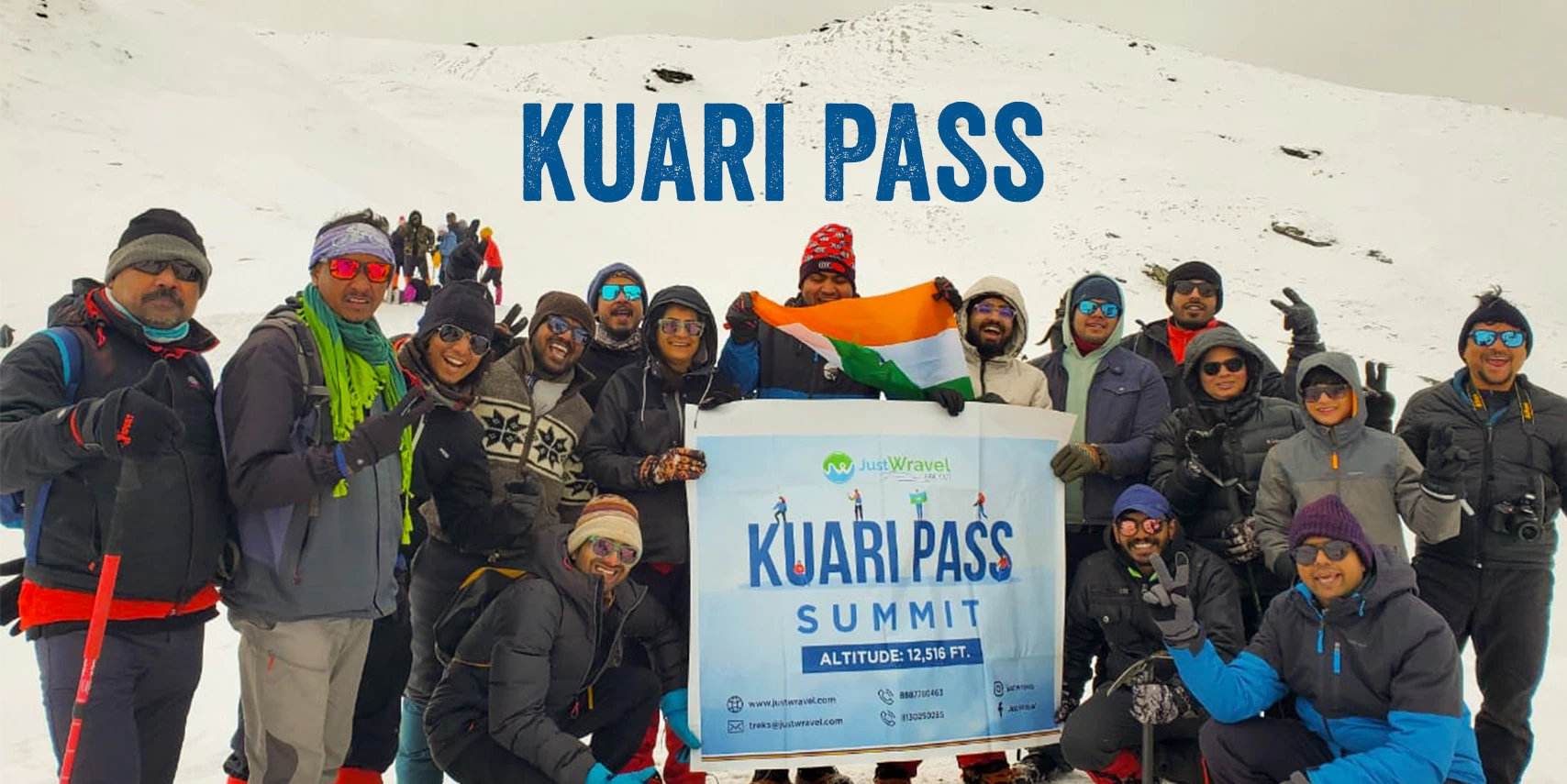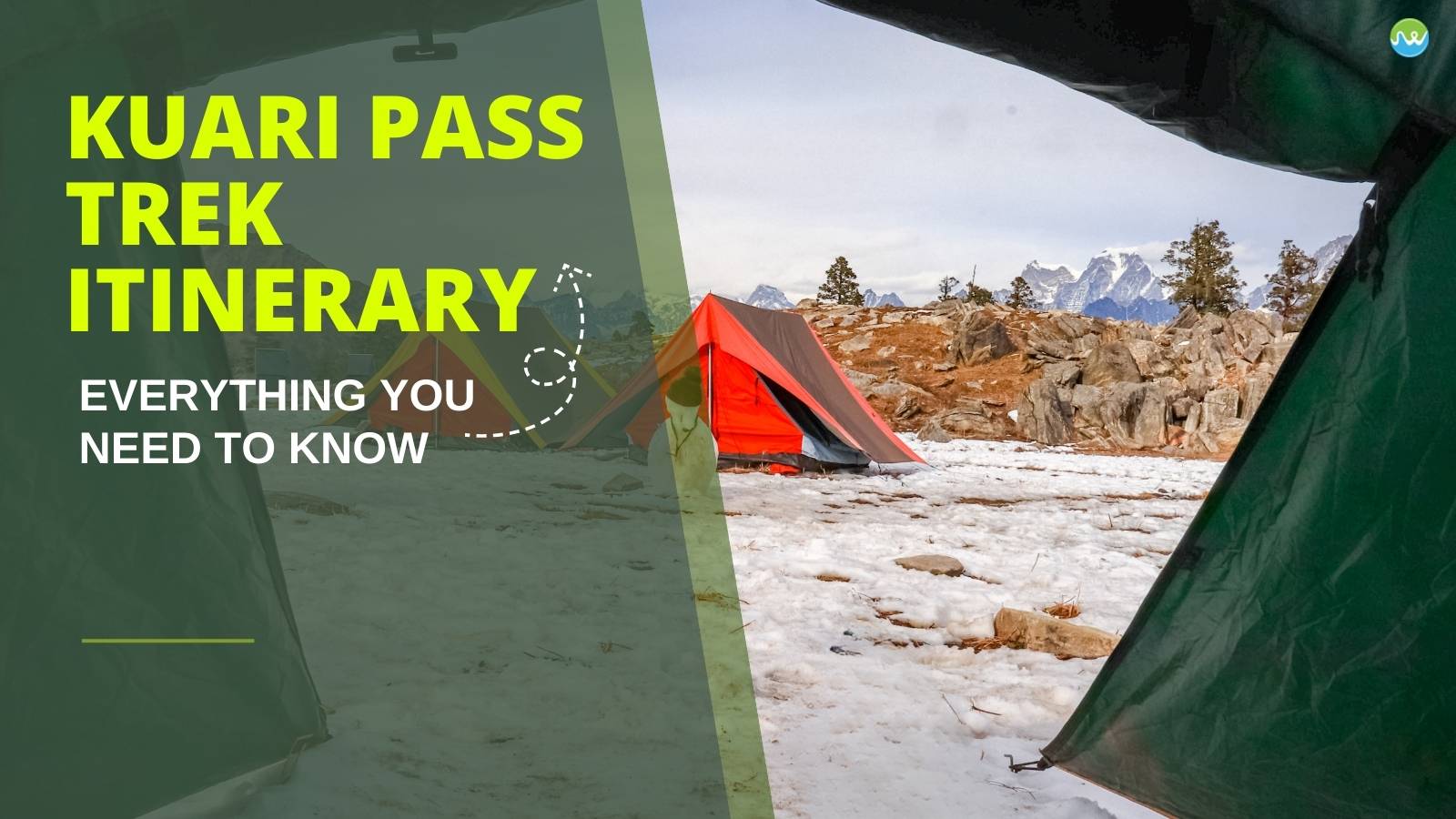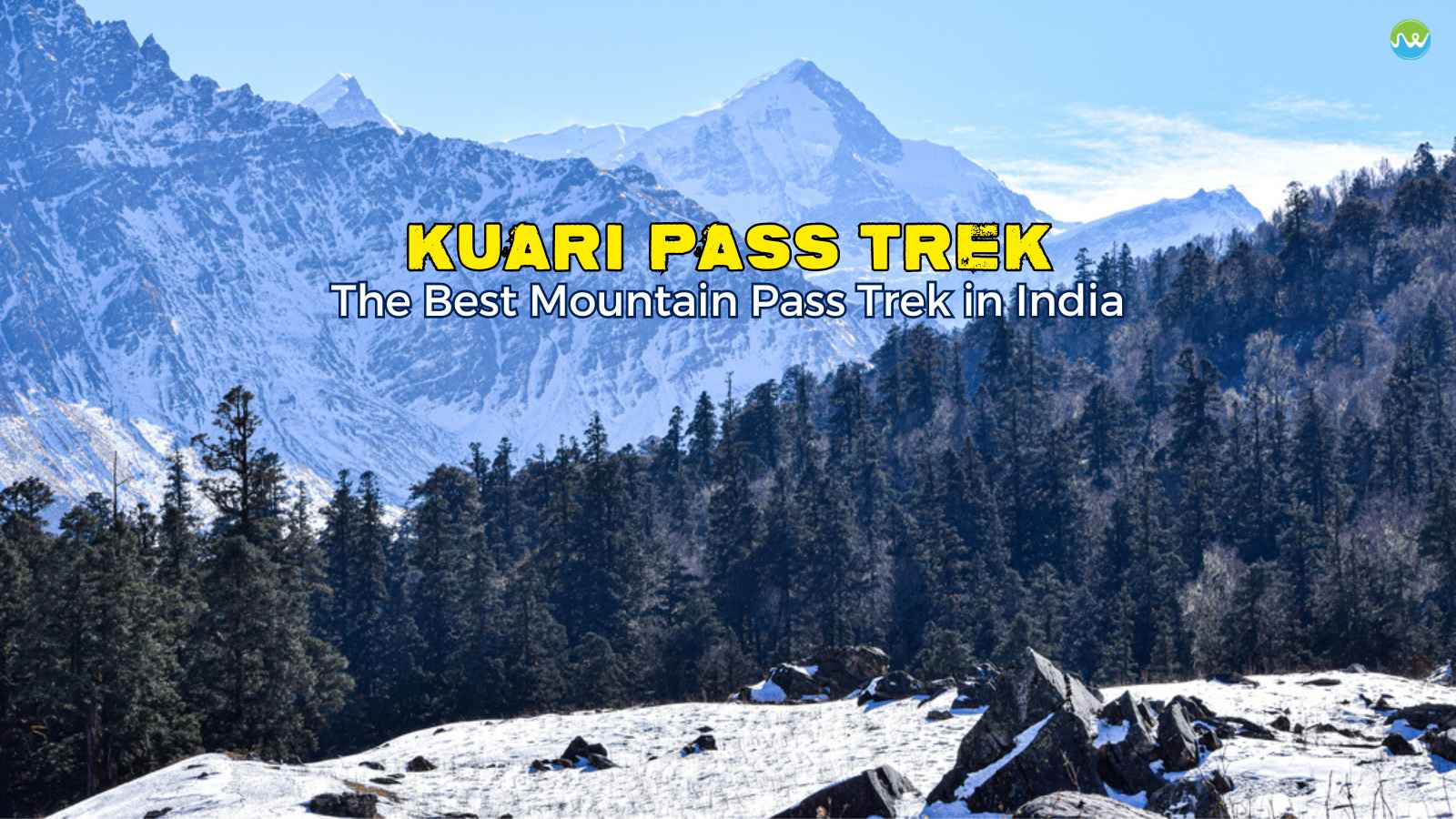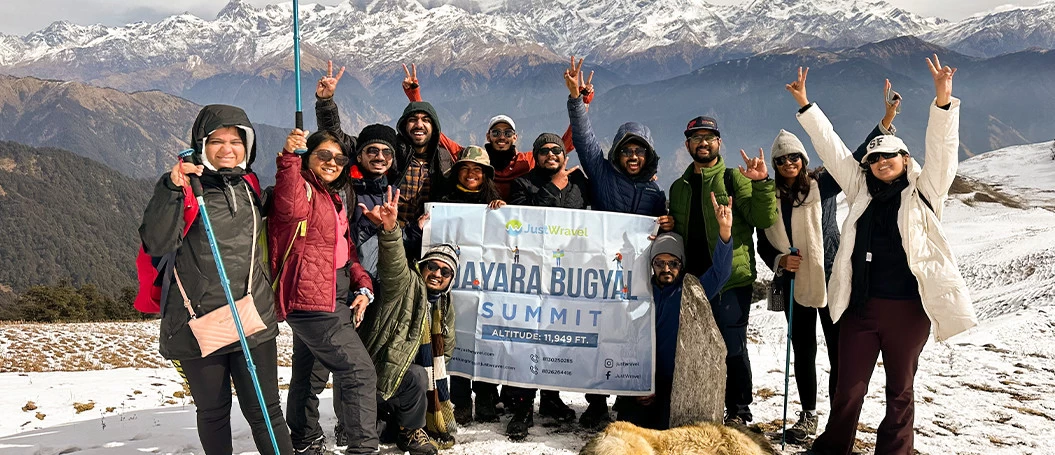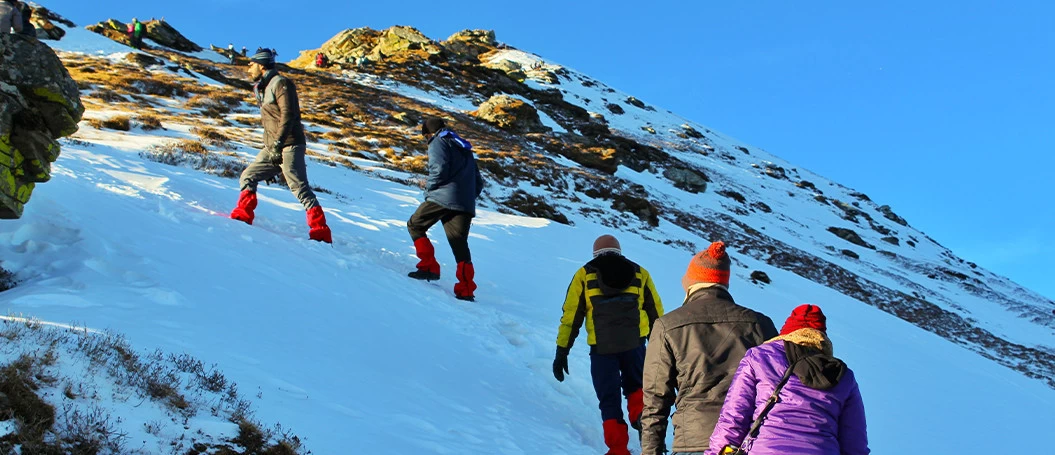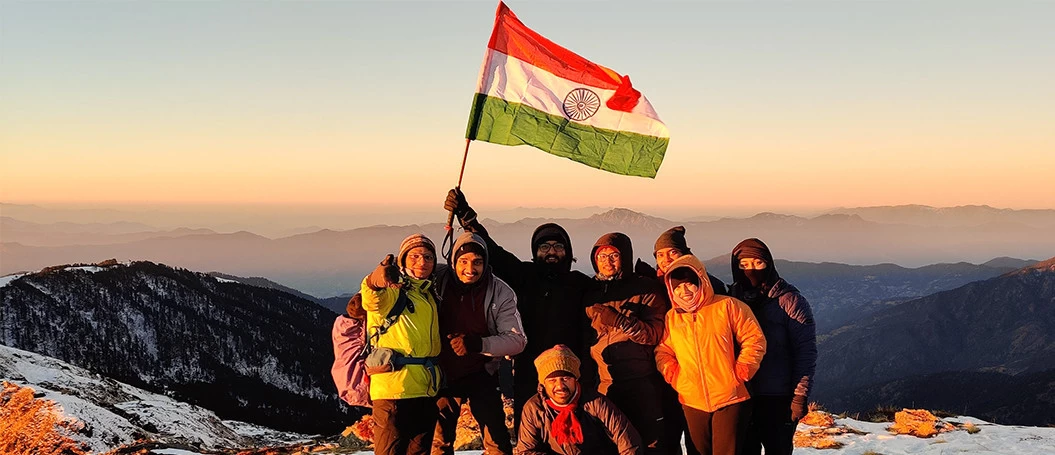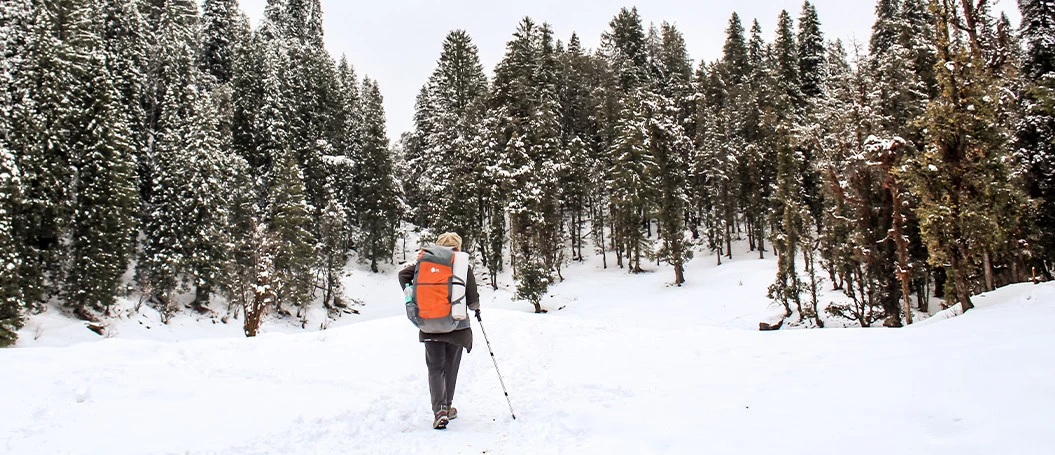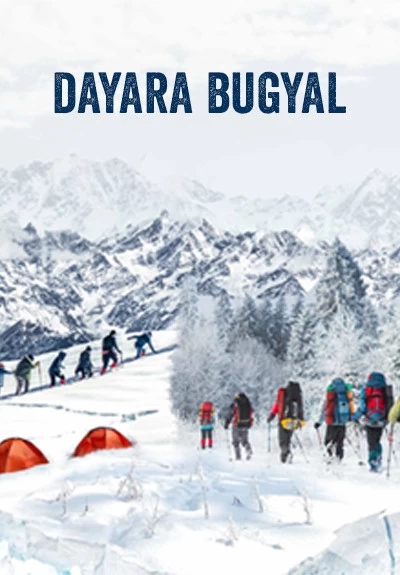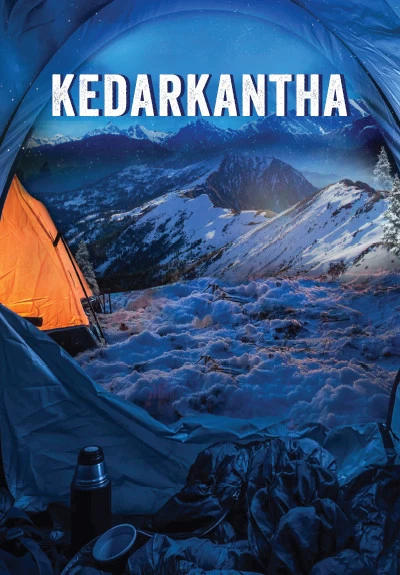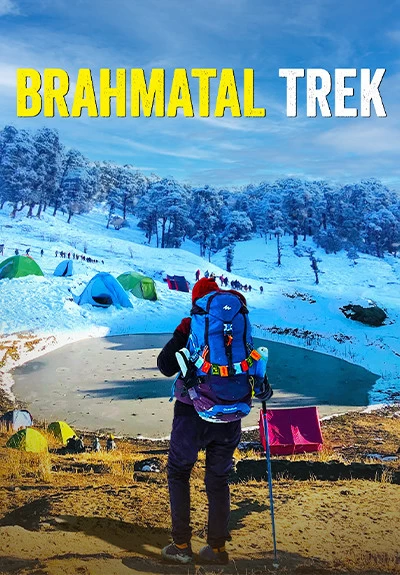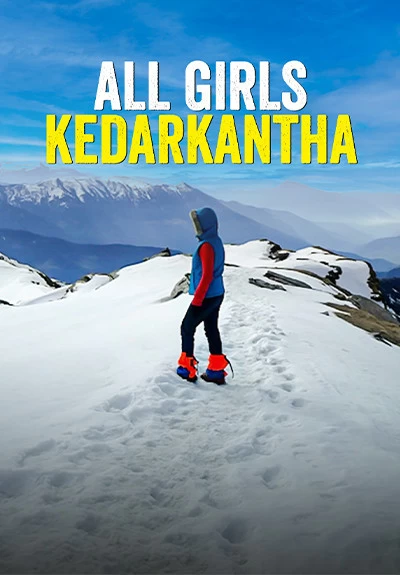
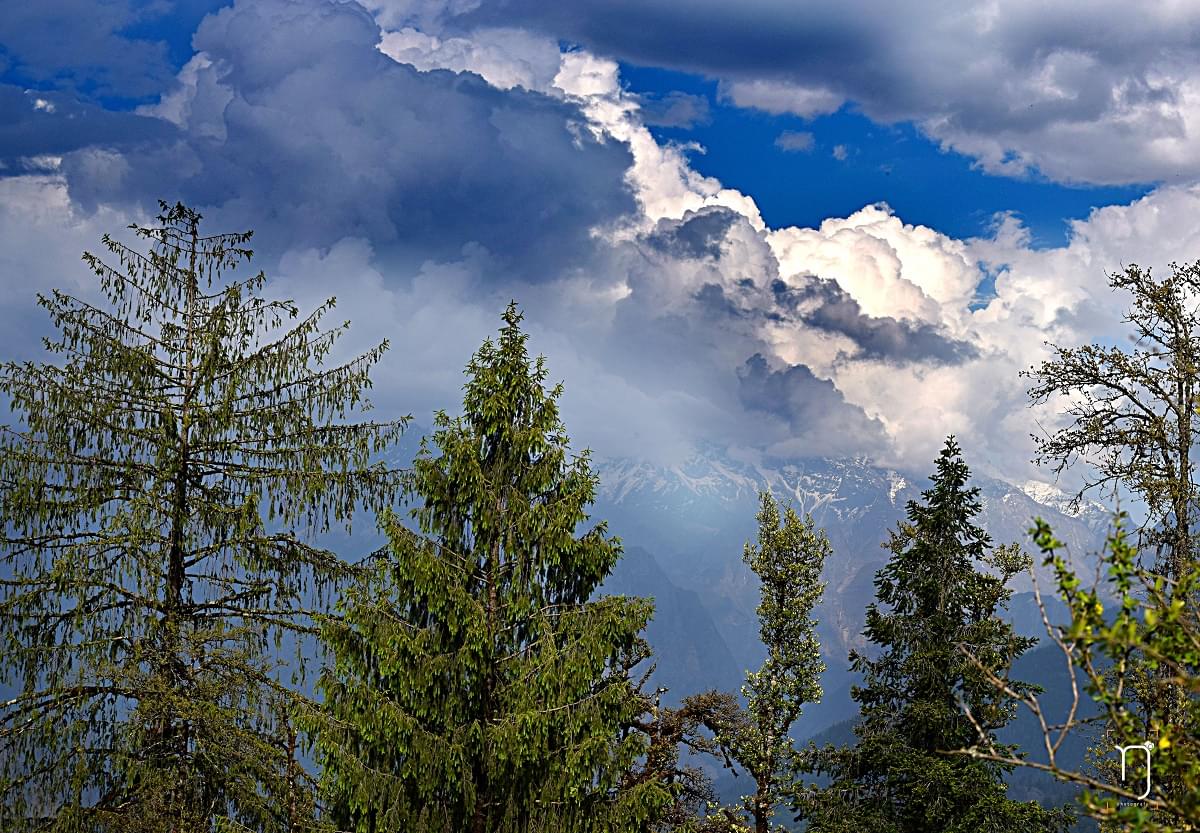
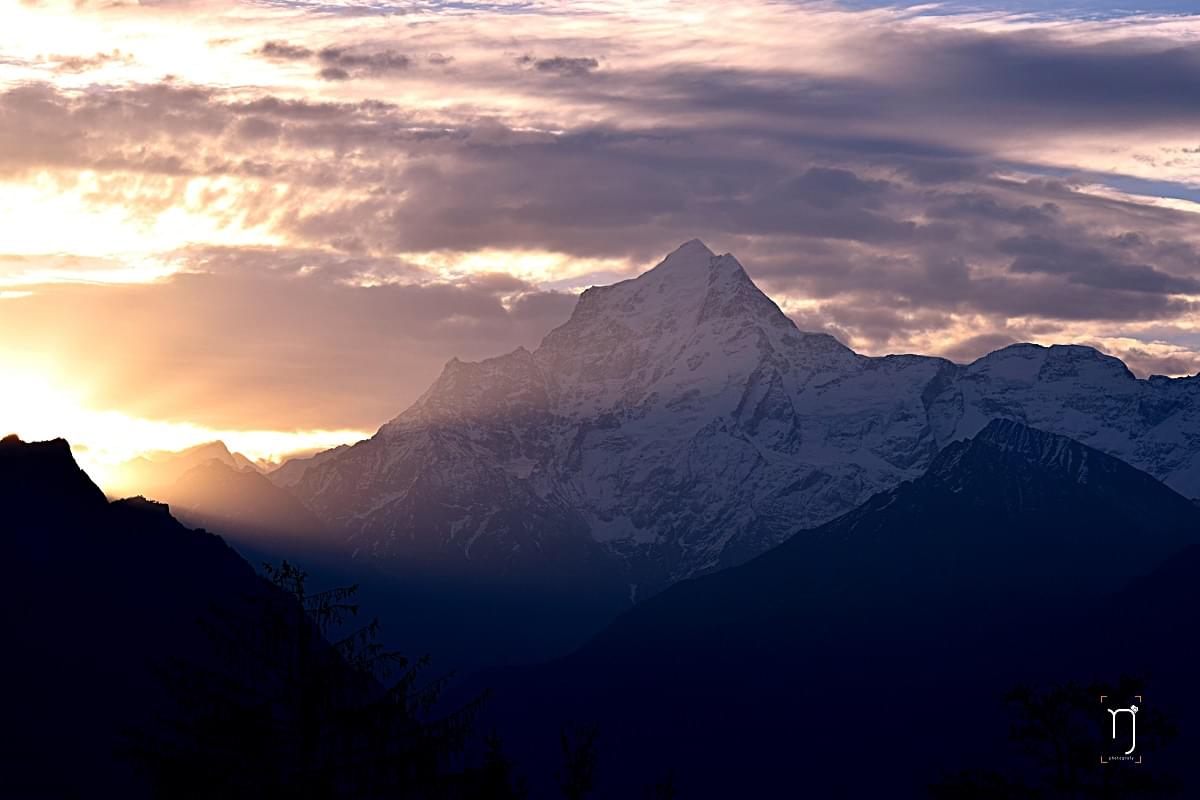
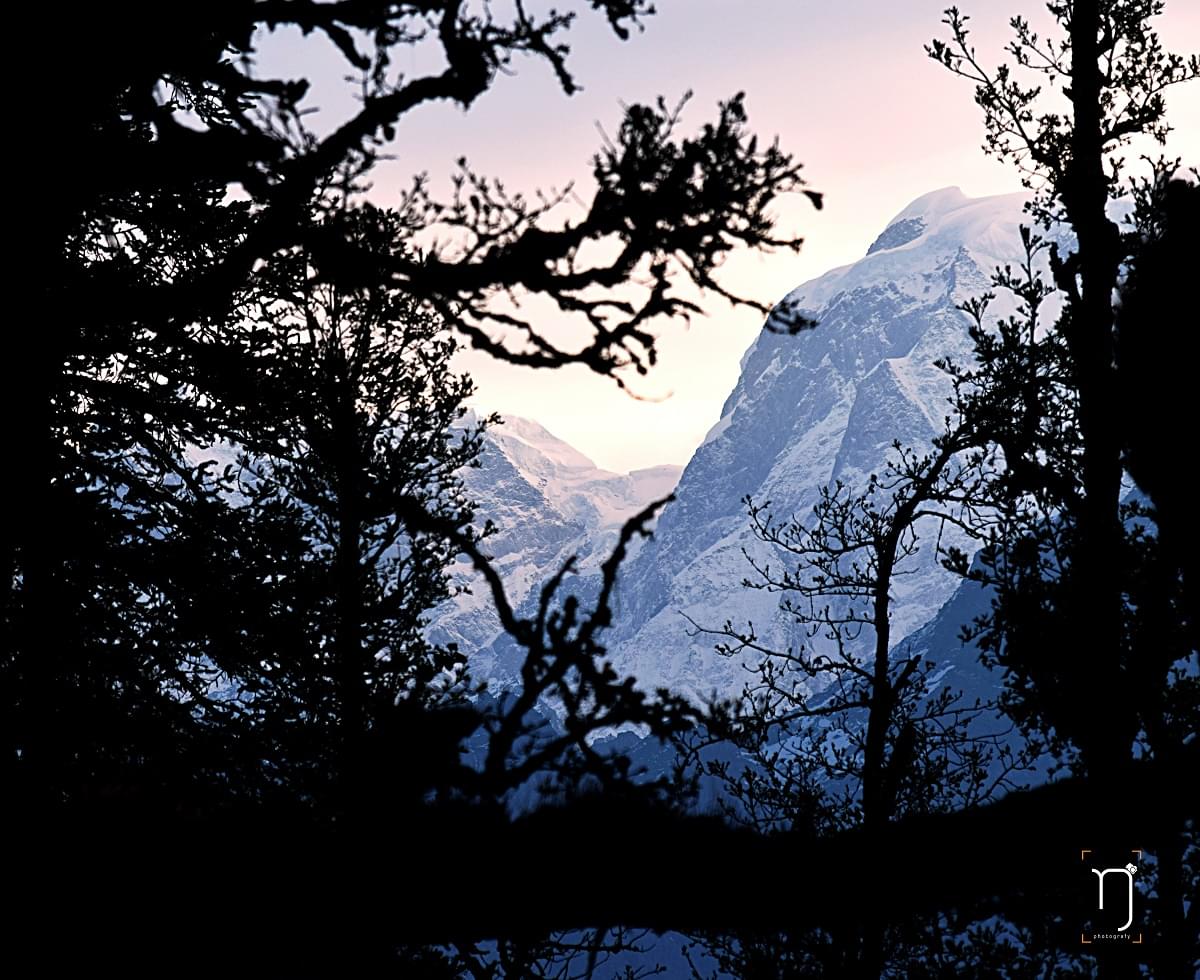
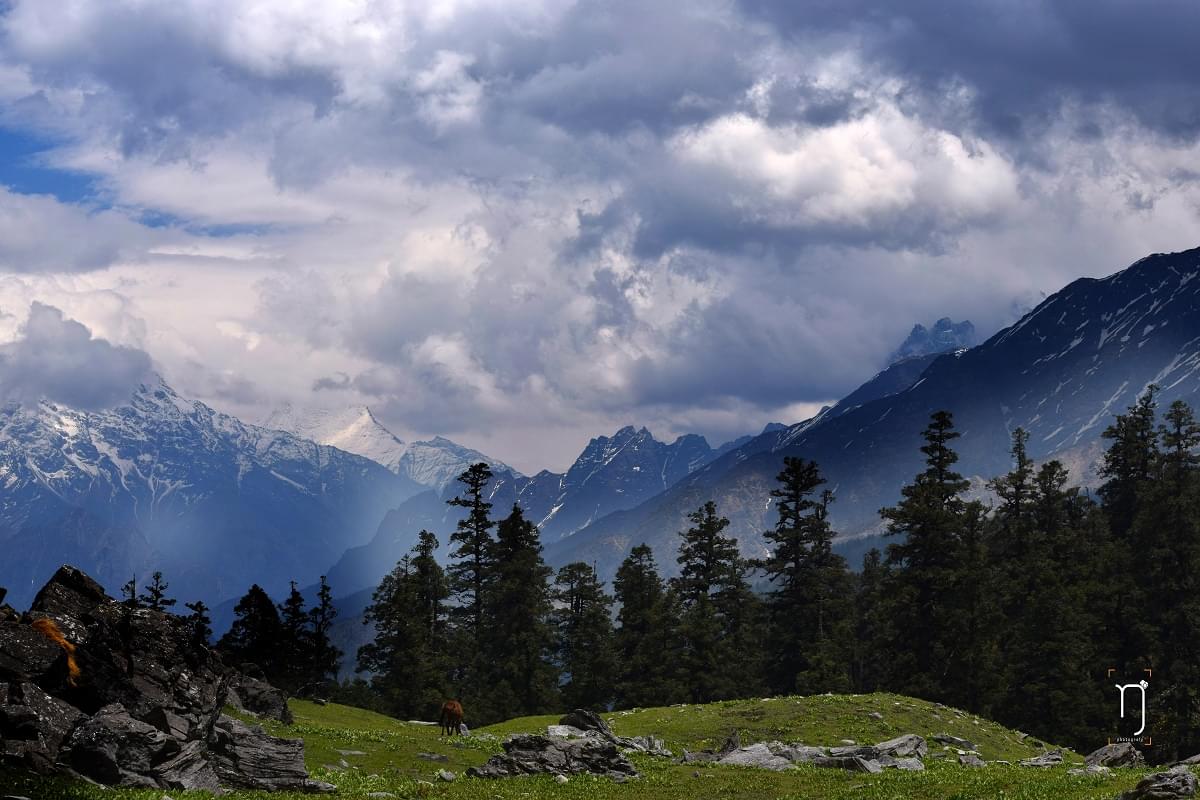
Kuari Pass Trek
Details
Inclusions
Safe Travel
Flexible Cancellation
Easy EMI
Certified Captains
24/7 Support
Overview
Nestled in the Garhwal region of the Himalayas, the Kuari Pass trek is one of the best winter treks that our country has to offer. Situated at an elevation of 12,516ft, it is also known as the Lord Curzon trail, named after the former Viceroy of India during the British Raj who was the first person to complete this trek in 1905. His connection to this trek is one of the reasons why it’s popular among not just Indian travelers but fascinates a lot of American and European travelers from all over the world as well.
The Kuari Pass trek itinerary follows the same path, as it was carried out back in the day, starting from Joshimath and ending at Kuari Pass, covering a 28km long trail that consists of gentle slopes, coniferous forests, and stunning views of the snow-capped mountains in the backdrop. During the long trail of the Kuari Pass Trek, we traverse through some of the hidden nearby villages like Tugasi, Guling, and Khullara where you get to take a closer look at the local customs and traditions of Uttarakhand. The trekking route with its scenic views of the Pangarchulla, Chaukhamba, Neelkanth, Dronagiri, Hathi Ghoda, and Nilgiri mountain ranges is what captivates the attention of travel enthusiasts and makes people seek out this particular trek. Not to mention that with its snow-covered oak forests and pearly meadows, it manages to leave a lasting impression on snow fanatics and nature lovers alike.
The trek starts from the town of Joshimath which is the base camp for the Kuari Pass trek and traverses through Himalayan hamlets followed by Oak and Deodar Forests and then giving way to some pristine Bugyals which are meadows stretched like a tapestry on the trail. The breathtaking view of the Nanda Devi Massif in the backdrop is the highlight of this trek. Camping under the stars, waking up to a spectacular view of the Himalayas, all while making memories that you will reminisce upon for the rest of your life, the Kuari Pass trek is more than just an adventure, it's an experience of a lifetime, one that you can’t miss out on.
Since the Kuari Pass trek comes in the easy-to-moderate category, it is convenient for both beginners as well as experts, making it accessible for a large group of people who are looking for trekking destinations during the winter season. Among other wonders that this journey has to offer, some lucky trekkers can discover paw prints of Himalayan bears and snow leopards giving them a glimpse at the wildlife that coexists in peace with nature. Overall, The trek to Kuari Pass is a blessing because it provides a perfectly balanced trip that offers adventure for thrill seekers as well as serenity for people who want to attain a certain sense of peace.
The best time to do the Kuari pass trek is from the months of November to March. Although it’s one of the few particular treks that is accessible for travel enthusiasts throughout the year, during these months, the weather in this region is perfect and makes the overall experience a thousand times better. So, if you have been spending your time, wondering and trying to plan the perfect winter trek, then look no further because this is as good as it gets.
Gallery




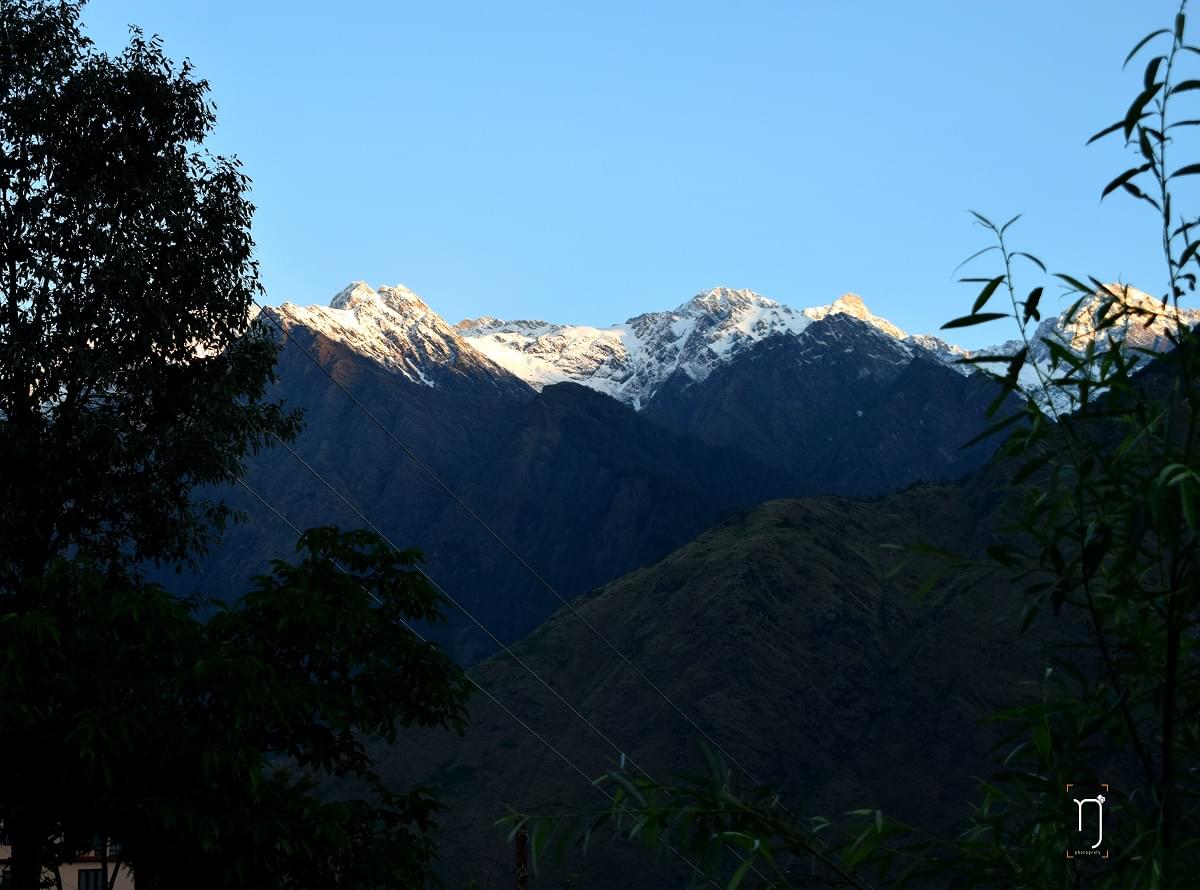
Itinerary
1
Day
Rishikesh to Joshimath (254 Kms, 10 Hours Drive)
2
Day
Drive from Joshimath to Tugasi (14 Kilometers, 45 Mins Drive) | Trek to Guling (4 Kilometers, 5 Hours)
3
Day
Trek from Guling to Khullara (6 Kilometers, 7 Hours)
4
Day
Trek to Kuari Pass | Back to Khullara (6 Kilometers, 7 Hours)
5
Day
Trek from Khullara to Tugasi (12 Kilometers, 6 Hours) | (Drive to Joshimath (14 Kilometers, 45 Mins Drive)
6
Day
Drive from Joshimath to Rishikesh (254 Kms, 10 Hours Drive) | End of tour
Age Limit (Trip Wise)
Weekend
Getaways
18-38
Himalayan
Treks
18-48
Backpacking
Trips
18-40
Biking
Trips
18-45
Customized
Trips
No Limit
Inclusions & Exclusions
| Inclusions | Exclusions |
Accommodation: 2 Nights in a Hotel / Homestay on a triple/quad sharing basis and 3 Nights Tented accommodation on a triple sharing basis. Transportation: Surface transfer from Rishikesh - Joshimath - Rishikesh by Sumo / Bolero / Tempo Traveller ( Depends on the number of travelers). Meals: All Meals from (day 1 Dinner to day 6 Morning tea ) are included. We provide simple nutritious vegetarian food on all days of the trek. Snacks: Morning / Evening Tea / Coffee with light snacks. Camping logistics: Trekking tent, Sleeping bags, Mattresses, Dining tent, Kitchen tent and Toilet tent. Trek Leader Qualified and Experienced Trek leader and support staff. Permits: All necessary fees and permits. (For Indians) Trekking Equipment: Gaiters, Micro Spikes, and Rope if required. Safety Equipment: Walkie / Talkie , Basic First Aid kit with Oximeter, Blood Pressure Monitor and Oxygen Cylinder. Guide ratio: Local experience guide ( depends on the group size). Others : Cloak Room facility available at base camp for extra luggage. | 5% GST Any expenses of personal nature. Meals during transit. Insurance of any kind. Unscheduled delay due to landslide. Cost Escalation due to “ Force Majeure and Evacuation charges”. Anything not mentioned explicitly in the above program. Note :- Bag offloading cost is Rs 1200 (maximum weight should not be more than 10 kg) |
Cancellation Policy
| Upto 21 days | 20-15 days | 14-8 days | 7-0 days | |
| Batch Shifting | ||||
| Cancellation Charge | Free Cancellation | 25% of the Trip Amount | 50% of the Trip Amount | 100% of the Trip Amount |
| Booking Amount | Refunded in mode of Credit Note | Adjusted in Refund Deduction | Adjusted in Refund Deduction | No Refund |
| Remaining Amount | Full Refund (minus) booking amount | Refund (minus) 25% of the trip amount | Refund (minus) 50% of the trip amount | No Refund |
Payment Policy
| Upto 21 days | 21-15 days | 14-08 days | 07-03 days | |
|---|---|---|---|---|
| Booking Amount | ||||
| 50% Payment | Optional | Compulsory | ||
| 75% Payment | Optional | Optional | Compulsory | |
| 100% Payment | Optional | Optional | Optional | Compulsory |
Things To Pack
Rucksack:
You must pick a good quality backpack with a comfortable fit and straps that won’t give you shoulder pain. You can check out your nearest Decathlon store for a good trekking backpack.
You must pick a good quality backpack with a comfortable fit and straps that won’t give you shoulder pain. You can check out your nearest Decathlon store for a good trekking backpack.
Day Bag / Day Pack:
When you head towards the summit, you are required to carry only a few necessary items and for that, you need a day backpack as you will leave your bigger one on the campsite.
When you head towards the summit, you are required to carry only a few necessary items and for that, you need a day backpack as you will leave your bigger one on the campsite.
Hiking Shoes :
Durable footwear designed for rugged terrains.
Durable footwear designed for rugged terrains.
Floaters or Sandals:
Although the entire trek requires a good quality shoe, you still need to let your feet breathe to avoid chafing and blisters. When you are at the camp, a good pair of sandals and floaters will help you to move freely.
Although the entire trek requires a good quality shoe, you still need to let your feet breathe to avoid chafing and blisters. When you are at the camp, a good pair of sandals and floaters will help you to move freely.
Tees / Tshirts:
You must keep at least three pairs of quick dry tees so that you can wash them in between stops for proper hygiene.
You must keep at least three pairs of quick dry tees so that you can wash them in between stops for proper hygiene.
Poncho:
A poncho is an evolved form of a raincoat that provides coverage to your body as well as your bag and ensures total water protection from rain.
A poncho is an evolved form of a raincoat that provides coverage to your body as well as your bag and ensures total water protection from rain.
Quick Dry Towel:
A quick dry towel will help in maintaining proper hygiene. It must dry quickly because the wet fabric will only increase the chance of bacterial growth.
A quick dry towel will help in maintaining proper hygiene. It must dry quickly because the wet fabric will only increase the chance of bacterial growth.
Sanitizer:
Essential for maintaining cleanliness while trekking.
Essential for maintaining cleanliness while trekking.
Sun Cap / Hat:
A lightweight sun cap with side flaps is perfect to keep your head cool and avoid sunburns on a sunny day.
A lightweight sun cap with side flaps is perfect to keep your head cool and avoid sunburns on a sunny day.
Sunscreen SPF 40+:
To avoid sunburns and chafing, you need to put on sunscreen as well as cold cream.
To avoid sunburns and chafing, you need to put on sunscreen as well as cold cream.
Water Bottle (Re-usable):
Hydration is extremely important when it comes to trekking. Carrying a water bottle that you can refill with Himalayan water is a must.
Hydration is extremely important when it comes to trekking. Carrying a water bottle that you can refill with Himalayan water is a must.
Personal Toiletries:
A bag with all your essentials including napkins, toothpaste, sanitizers, paper soap, etc should be carried in a ziplock bag.
A bag with all your essentials including napkins, toothpaste, sanitizers, paper soap, etc should be carried in a ziplock bag.
Personal Medication / First Aid:
A few cuts and bruises are almost inevitable when you are on a trek so carrying a medical kit with bandages, Dettol, etc is necessary.
A few cuts and bruises are almost inevitable when you are on a trek so carrying a medical kit with bandages, Dettol, etc is necessary.
Sun Glasses / Reading Glasses:
Photochromatic glasses are specs that are designed to transform into anti-glare shades depending upon exposure to the sun. They are good when it comes to eye protection but one can also opt for clip-on glasses etc.
Photochromatic glasses are specs that are designed to transform into anti-glare shades depending upon exposure to the sun. They are good when it comes to eye protection but one can also opt for clip-on glasses etc.
Charger:
To keep your electronic devices powered during the trip.
To keep your electronic devices powered during the trip.
Power Bank:
Ensures your devices stay charged when there are no outlets.
Ensures your devices stay charged when there are no outlets.
Personal Documents & ID's:
Identification proofs like Aadhar Card, Drivers License.
Identification proofs like Aadhar Card, Drivers License.
Laundry Bag (Waterproof):
In case your clothes get wet or your garments don’t dry, you can carry them in polythene. However, make sure that all the plastic that you are carrying into the woods leaves with you. Don’t litter in the mountains.
In case your clothes get wet or your garments don’t dry, you can carry them in polythene. However, make sure that all the plastic that you are carrying into the woods leaves with you. Don’t litter in the mountains.
Track Pants:
A good pair of track pants made of polyester will let your skin breathe. They’re lightweight, dry easily, and comfortable to walk around in. You can easily avoid chafing and rashes by investing in a good pair of track pants.
A good pair of track pants made of polyester will let your skin breathe. They’re lightweight, dry easily, and comfortable to walk around in. You can easily avoid chafing and rashes by investing in a good pair of track pants.
Trekking Shoes:
A good trekking shoe is comfortable, provides ankle support, and has a good grip as well. They shouldn’t be chunky, instead, they should be lightweight and sturdy.
A good trekking shoe is comfortable, provides ankle support, and has a good grip as well. They shouldn’t be chunky, instead, they should be lightweight and sturdy.
Cotton Socks:
Cotton socks are extremely comfortable to move around in and are lightweight as well which is why you can always count on a good pair of cotton socks while trekking. However, keep in mind to change them and avoid wearing them when they are wet.
Cotton socks are extremely comfortable to move around in and are lightweight as well which is why you can always count on a good pair of cotton socks while trekking. However, keep in mind to change them and avoid wearing them when they are wet.
Woolen Socks:
A good pair of woolen socks, especially merino, are comfortable, limit odors and provide adequate insulation from the cold so you can wear them at night.
A good pair of woolen socks, especially merino, are comfortable, limit odors and provide adequate insulation from the cold so you can wear them at night.
Woolen Gloves:
Insulated gloves help in maintaining proper body heat in your hands and also provide a better grasp on trekking poles.
Insulated gloves help in maintaining proper body heat in your hands and also provide a better grasp on trekking poles.
Main Jacket:
It’s emphasized that you need to carry proper layers so you can avoid getting cold which is why you need to carry a heavy jacket that you can put on over your other clothes.
It’s emphasized that you need to carry proper layers so you can avoid getting cold which is why you need to carry a heavy jacket that you can put on over your other clothes.
Woolen Cap:
A woolen cap will help prevent cold when you ascend to high altitude. You can also cover your ears to avoid any pain and discomfort you might face in them when going at high altitudes.
A woolen cap will help prevent cold when you ascend to high altitude. You can also cover your ears to avoid any pain and discomfort you might face in them when going at high altitudes.
Hoodie:
A versatile layering option for various temperatures.
A versatile layering option for various temperatures.
Scarf / Balaclava:
Along with sun rays and chilly winds, you also get hit by dirt and grime during treks which is why it's important to carry a scarf or balaclava so you can cover your face when needed.
Along with sun rays and chilly winds, you also get hit by dirt and grime during treks which is why it's important to carry a scarf or balaclava so you can cover your face when needed.
Head Lamp:
You can’t rely on moonlight when you are in the mountains. A torch or even a headlamp with a fresh pair of batteries is always a good idea to bring along.
You can’t rely on moonlight when you are in the mountains. A torch or even a headlamp with a fresh pair of batteries is always a good idea to bring along.
Trekking Pole:
The trekking pole assists in more than one way. It saves energy while also providing stability and helps you to maintain proper balance.
The trekking pole assists in more than one way. It saves energy while also providing stability and helps you to maintain proper balance.
Camera:
This should be obvious. To make sure that you get to capture all the great moments from your trek. Make sure that you have enough storage and some extra batteries as well.
This should be obvious. To make sure that you get to capture all the great moments from your trek. Make sure that you have enough storage and some extra batteries as well.
Riding Gear:
If your trip involves biking or motorcycling.
If your trip involves biking or motorcycling.
Moisturiser & Cold Cream:
To avoid sunburns and chafing, you need to put on sunscreen as well as cold cream.
To avoid sunburns and chafing, you need to put on sunscreen as well as cold cream.
Lip Balm:
Your lips can become chapped due to the harsh cold winds so it's important to keep them moisturized.
Your lips can become chapped due to the harsh cold winds so it's important to keep them moisturized.
Sanitary Pads:
Essential for feminine hygiene.
Essential for feminine hygiene.
Insect Repellent:
Guards against pesky bugs and insects.
Guards against pesky bugs and insects.
Cash:
Emergency funds for unexpected situations.
Emergency funds for unexpected situations.
Thermals:
Thermal is a piece of garment that helps in keeping your body warm in cold temperatures. It is a necessary item that you need when going on a high-altitude trek.
Thermal is a piece of garment that helps in keeping your body warm in cold temperatures. It is a necessary item that you need when going on a high-altitude trek.
Snacks / Dryfruits / Energy Bar:
Provides quick energy on the go.
Provides quick energy on the go.
Positive Attitude:
The most important item for a successful trek or trip, keeping your spirits high and adaptable to the challenges of the journey.
The most important item for a successful trek or trip, keeping your spirits high and adaptable to the challenges of the journey.
How to Reach Kuari Pass Trek
By Air: The nearest airport to Joshimath is Jolly Grant Airport in Dehradun, located at a distance of 272 km from Joshimath. This airport is well-connected to major Indian cities such as Delhi, Mumbai, and Bangalore. From the airport, you can either hire a cab or take the road to reach Joshimath.
By Rail: If you prefer to travel by train, the closest railway station to Joshimath is Rishikesh railway station, which is located 250 kilometers away. Rishikesh has excellent railway connections to major destinations in India. From Rishikesh, you can easily reach Joshimath by well-maintained roads via taxis or buses. These transportation options are also available from other popular destinations like Srinagar, Rudraprayag, Chamoli, and more.
By Road: To reach Joshimath from Delhi by road, you have a distance of 484 km to cover. The journey takes approximately 14 hours via NH334. Alternatively, you can opt for the NH 7 route, but be aware that it will increase both the distance and the time taken. If you choose this road, you will need to cover 527 km, and it will take around 15 hours to reach Joshimath. Another option is to take a bus from Delhi to Rishikesh. From Rishikesh, you can then continue your journey to Joshimath by either hiring a private car or sharing a taxi.
Best Time to Visit Kuari Pass Trek
It might come as a surprise, but the truth is, Kuari Pass Trek is an all-year-round adventure. Each season presents a different color canvas for trekkers. The best time for the Kuari Pass Trek depends entirely on what you wish to experience during the trek. If you are a snow enthusiast, then winter is the best time for you.
Kuari Pass in Winter
During the winter season, people trek to Kuari Pass in search of snow-covered landscapes and breathtaking views. Once vibrant scenery transforms into a majestic winter wonderland, adorned with snowy blankets that gracefully drape the surroundings you won’t be able to resist yourself. Immersed in this winter wonderland, one can find themselves amidst towering pines, majestic oak trees, and delicate dwarf rhododendrons. From the very first day, a vast panorama of India’s mightiest mountains unfolds before your eyes, leaving you in awe. However, it is important to note that the presence of snow adds an extra level of difficulty to the trek. Therefore, thorough preparation is essential for those embarking on this winter adventure.
Why Trek with JustWravel?
Choosing the right trek is easy, but selecting the right trekking company is the real challenge, especially when venturing into the remote areas of the Himalayas. The experience and credibility of a trekking organization are crucial factors you need to consider. We understand these concerns, and that’s why we want to show you why JustWravel is your ideal trekking partner for the Kuari Pass Trek.
Put on your Shark Tank sunglasses because, after our pitch, you'll be eager to pack your bags for the Kuari Pass Trek !
- The Safest Travel Community in India: For us, safety comes first, and the fun, adventure, and thrill of a trek come later.
- From the Mountains with Love: Yes, that’s us. Most of our trekking coordinators are from the mountains; they share year-round knowledge of how pahadi life is. Nobody knows the mountains better than the people who have grown up playing on its slopes. To ensure you have the safest and most enthralling experience, we make sure to hire local guides. Most of our vendors are also natives, which assures an exchange of healthy and profitable business on both ends.
- Certified Trek Captains: Our Trek Captains are both BMC and AMC (Advanced Mountaineering Course) certified and are highly skilled medics. They know every nook and cranny of the trail and are equipped with extensive knowledge to handle any situation.
- The Experience of Years: Our knowledge is not merely theoretical. We ventured into the mountains years ago, and through our experiences, we’ve learned valuable lessons that we pass on to our trekkers.
- Taking What We Took There: This is what sets us apart in the market. We never litter the mountains. What we bring to the mountains, we take back for sure. Read below to learn more about our Keep The Trails Alive campaign.
Keep The Trails Alive
Don’t be a Crap Bag
You are in nature’s lap
Kindly take that garbage back
If you’re wondering what our Keep the Trails Alive campaign is all about, it’s simple: without proper management, many sacred mountains are facing littering due to over-tourism. As responsible trekkers, we will never let that happen. If you’re trekking with JustWravel, you need to ensure that everything you carry in, you carry out. We will never leave anything behind except our love and a piece of our hearts for the majestic views we experience.
- Reusable: Always carry your own water bottle and cutlery to reuse them.
- Carry Out What You Carry In: Always pack out all your waste, including food wrappers, bottles, tissues, and sanitary items. Never leave anything behind.
- Use Toilet Tents and Dig Pits: Bury human waste in deep pits (6+ inches) to prevent contamination. Dispose of toilet paper and sanitary waste in your trash bag.
- Manage Food Waste Carefully: Bury leftover food and peels away from water sources. Avoid feeding wildlife to prevent dependency.
- Dispose of Waste Properly: Carry out all waste and dispose of it responsibly at designated collection points or in towns. Avoid burning waste.
- Avoid Polluting Water Sources: Wash dishes, clothes, and yourself away from streams and lakes. Use biodegradable soap sparingly.
- Educate Yourself and Others: Learn local waste management practices and follow them. Teach fellow trekkers and porters about responsible disposal.
Everything You Need To Know About JW Trekking
Dry Pits
Dry pits are a crucial waste management solution in trekking environments, particularly in remote areas where traditional plumbing is unavailable. These systems consist of deep holes dug into the ground, designed to safely contain human waste. The primary benefit of dry pits is their ability to facilitate the natural decomposition of waste, which minimizes the environmental impact associated with human activity in pristine natural areas. By using dry pit systems, trekkers help protect water sources from contamination. The implementation of dry pits not only improves hygiene for trekkers by providing designated areas for sanitation but also promotes awareness and education about sustainable practices within local communities.
Bathing
While the idea of bathing after a long day of trekking may seem appealing, it is generally discouraged for several important reasons. As trekkers ascend to higher altitudes, they encounter significantly colder temperatures, especially at night. Bathing in cold water can lead to rapid heat loss, particularly in vulnerable areas such as the legs and head, increasing the risk of hypothermia. Additionally, access to bathing facilities is often limited in remote trekking areas, making it impractical and unsafe. Engaging in bathing can also cause the body to expend extra energy to maintain its core temperature, which may hinder the acclimatization process necessary for high-altitude trekking. Instead, most trekking itineraries include a stop at a base camp where trekkers can enjoy warmer conditions and facilities for bathing, allowing for a more comfortable and safer experience.
Bonfire
Bonfires are typically prohibited during treks for several compelling reasons that prioritize environmental conservation and safety. One of the main concerns is the environmental impact of gathering firewood, which can lead to deforestation and habitat destruction in ecologically sensitive areas. Removing wood from these environments disrupts local ecosystems and can have long-lasting effects on biodiversity. Additionally, open fires pose a significant risk of attracting wildlife, including potentially dangerous animals such as bears. The smell of food and smoke can draw these creatures closer to campsites, increasing the likelihood of dangerous encounters for trekkers.
Vegetarian Food
Providing vegetarian meals during treks is a deliberate choice that offers numerous benefits. Vegetarian food is generally easier to store and prepare in remote areas, as ingredients like lentils, beans, and grains have longer shelf lives and require less refrigeration. This practicality is crucial in environments where access to resources is limited. Additionally, vegetarian meals minimize the risk of attracting wildlife to campsites, which can be a significant safety concern. Non-vegetarian food can draw animals closer, creating potential dangers for trekkers. Vegetarian meals can be highly nutritious, offering essential vitamins, minerals, and protein that are vital for sustaining energy during physically demanding treks. Ingredients such as nuts, seeds, and legumes are energy-dense and provide the necessary fuel for trekkers. Lastly, vegetarian cuisine can be diverse and flavorful, incorporating local ingredients and spices that enhance the trekking experience, allowing trekkers to enjoy a variety of delicious dishes while minimizing their environmental impact.
Plan B and C
Having contingency plans, often referred to as Plan B and C, is a vital aspect of trekking, especially in mountainous regions where conditions can change unexpectedly. The weather in these environments can be unpredictable, with storms, snow, or high winds potentially altering planned routes. By preparing alternative plans, trekkers can adapt to changing conditions and ensure their safety. Experienced trekking organizations emphasize the importance of these backup plans, as they allow for swift responses in the event of emergencies, such as injury or illness. This adaptability is crucial for maintaining the safety and comfort of all participants. With years of trekking experience, guides develop a keen understanding of the mountains and can assess conditions effectively, ensuring that trekkers remain safe and comfortable throughout their journey. Ultimately, being prepared with multiple plans enhances the overall trekking experience, allowing trekkers to enjoy their adventure with the confidence that they can navigate any challenges that may arise.
Acclimatization
Acclimatization is a critical process that allows trekkers to adjust to the physiological changes that occur when ascending to high altitudes. As trekkers gain elevation, the body must adapt to decreased oxygen levels and lower atmospheric pressure to prevent altitude sickness, which can occur if one ascends too quickly without allowing sufficient time for adjustment. Effective acclimatization involves a gradual ascent, ideally limiting elevation gain to no more than 300-500 meters (about 1,000-1,600 feet) per day above 3,000 meters (approximately 9,800 feet). This slow increase allows the body to adapt to the changing environment. Staying well-hydrated is also essential, as dehydration can exacerbate symptoms of altitude sickness; trekkers should aim to drink at least 3-4 liters of water daily. Incorporating rest days at higher altitudes is another important strategy, as these days allow the body to adjust while engaging in light activities. Trekkers should also be attentive to their bodies, recognizing the signs of altitude sickness, which may include headaches, nausea, dizziness, and fatigue. If symptoms arise, descending to a lower altitude is often the most effective course of action. Lastly, consuming a balanced diet rich in carbohydrates can help provide the energy needed for acclimatization, with foods that are easy to digest and high in calories being particularly beneficial during treks. Understanding and implementing these key aspects of acclimatization can significantly enhance the safety and enjoyment of trekking experiences in high-altitude environments.
VIDEOS
Memories for Life
posts
Instagram Images
REVIEWS
What our Clients Say About Us
blogs
Our Blogs
Faq
Have any Doubts
What kind of food can I get on the Kuari Pass Trek?
There are no restaurants available, trekkers can carry some packaged foods or snack items with them
What Does the Kuari Pass Trek Include?
Stretching over 4 days and 6 if you include the Rishikesh stops, the trek starts from the village of Dhak, in the beautiful Nanda Devi National Park. The spectacular view of Mt. Nanda Devi and the forest views are the trip's highlights.
What's the Best Season for Kuari Pass Trek?
Spring offers you the best of both worlds - while not too cold, the national park's spring flowers are in full bloom, and trekkers and can still see remnant snow.
How far is Mt. Nanda Devi from Kuari Pass Trek?
Mt. Nanda Devi is about 40 kilometres from the pass. The mountain's view is the highlight of the trek.
How Cold Does Kuari Pass Trek Get In the Winter?
Winters at Kuari are difficult - temperatures range from 12 degrees celsius all the way to -8 degrees
How far is Kuari Pass Trek from Dehradun?
The distance is 148 kilometres. As mentioned, buses are the reccomended method over the Nanda Devi Express.
Where is Kuari Pass Trek located?
Kuari pass is located in the western part of Nanda Devi Sanctuary in Uttarakhand.
Read More: The Kuari Pass Trek Guide
How many kilometers does the whole Kuari Pass trek cover?
The total distance covered during the Kuari pass trek on the Dhak-Kuari Pass-Auli trail is 21.5 km.
Read more about the route - https://www.justwravel.com/blog/kuari-pass-trek-itinerary/
Can you go to Kuari Pass Trek by Road?
There are no direct buses from Delhi to Joshimath. From ISBT Kashmere Gate in Delhi, you can take overnight UKRTC buses and Volvos to Haridwar. The gap between Delhi and Haridwar is approximately 222 kilometres. From Delhi to Haridwar, you can also take a taxi or an outstation cab.
Are guest houses available to stay during or amidst the Kuari Pass trek?
As Kuari Pass trek area is uninhabitable, there are no guest houses amidst the trek, though you can bring your tents and equipments to help with
How long do we walk each day?
The average daily walking distance is 7- 9 km, and trekkers can complete it in 5-7 hours. Walking will not be a challenge for anyone because the trek is simple.
Read more about the route: Kuari Pass Trek Itinerary
Which is the last ATM avaliable during the journey?
Joshimath has the last ATM on the way to the base camp.
Is the network available throughout the journey?
There are a few places where you can rely on a stable communication network. At Joshimath, Dhak village, and Guling, you can find decent network and internet connectivity.
Should a person be physically sound for this Kuari Pass trek?
Yes! a good level of fitness is required for the person to complete the trek.
What is the maximum altitude during Kuari Pass trek?
Kuari Pass trek reaches a maximum altitude/height of 12,516 ft.
What is the minimum age limit during the Kuari Pass trek?
14 years is the minimum limit, however they are supposed to be accompanied by their parents
What kind of shoes should be apt for the Kuari Pass trek?
The most important aspect of the trek are good trekking shoes, your trekking shoes should be warm, and made of waterproof material.
What is the starting point for the Kuari Pass Trek?
Joshimath is the starting point for the Kuari Pass Trek.
Read more: The Kuari Pass Trek Guide
What are the nearby places to go from Kuari Pass Trek?
Auli, Nanda Devi Peak, Trishul Peak, Gorson Bugyal, Tali Lake
Read More: The Kuari Pass Trek Guide
Which mobile service/internet provider works best at Kuari Pass Trek?
Vodafone, Jio, Airtel and BSNL are the prominent networks, Kuari Pass has a limited network and connectivity.
What is the level of fitness expected from the participants?
Any trek needs a high level of fitness to ensure that you have a good time.
Should I be carrying a medical kit?
Yes, it is always advisable to bring your own medicine on every trek, regardless of whether the organisers have it.
Can senior citizens do this Kuari Pass trek?
If you are a senior citizen, bring a medical certificate from your doctor stating that you are eligible for adventure activities such as trekking.
What is the difficulty level for the Kuari Pass trek?
Kuari Pass is an easy-moderate trek
Read More: The Kuari Pass Trek Guide
Is camping allowed on the Kuari Pass Trek?
You can camp amidst the lush green meadows, consisting of vast green pastures with Himalaya Views.
How many routes are there to reach Kuari Pass Trek?
There are a total of four routes for the destination:
1. Ghat, Ramni, Sanatoli to Kuari Pass, 6 days
2. Joshimath, Auli and Gorson to Kuari Pass, 5 days
3. Joshimath, Mirag, Tugasi and Khulara to Kuari Pass, 5 days
4. Tapovan, Khulara to Kuari Pass, 5 days
Read more about the route - Kuari Pass Trek Itinerary
TRIPS
Related Trips





Kuari Pass Trek
Details
Inclusions
Safe Travel
Flexible Cancellation
Easy EMI
Certified Captains
24/7 Support
Overview
Nestled in the Garhwal region of the Himalayas, the Kuari Pass trek is one of the best winter treks that our country has to offer. Situated at an elevation of 12,516ft, it is also known as the Lord Curzon trail, named after the former Viceroy of India during the British Raj who was the first person to complete this trek in 1905. His connection to this trek is one of the reasons why it’s popular among not just Indian travelers but fascinates a lot of American and European travelers from all over the world as well.
The Kuari Pass trek itinerary follows the same path, as it was carried out back in the day, starting from Joshimath and ending at Kuari Pass, covering a 28km long trail that consists of gentle slopes, coniferous forests, and stunning views of the snow-capped mountains in the backdrop. During the long trail of the Kuari Pass Trek, we traverse through some of the hidden nearby villages like Tugasi, Guling, and Khullara where you get to take a closer look at the local customs and traditions of Uttarakhand. The trekking route with its scenic views of the Pangarchulla, Chaukhamba, Neelkanth, Dronagiri, Hathi Ghoda, and Nilgiri mountain ranges is what captivates the attention of travel enthusiasts and makes people seek out this particular trek. Not to mention that with its snow-covered oak forests and pearly meadows, it manages to leave a lasting impression on snow fanatics and nature lovers alike.
The trek starts from the town of Joshimath which is the base camp for the Kuari Pass trek and traverses through Himalayan hamlets followed by Oak and Deodar Forests and then giving way to some pristine Bugyals which are meadows stretched like a tapestry on the trail. The breathtaking view of the Nanda Devi Massif in the backdrop is the highlight of this trek. Camping under the stars, waking up to a spectacular view of the Himalayas, all while making memories that you will reminisce upon for the rest of your life, the Kuari Pass trek is more than just an adventure, it's an experience of a lifetime, one that you can’t miss out on.
Since the Kuari Pass trek comes in the easy-to-moderate category, it is convenient for both beginners as well as experts, making it accessible for a large group of people who are looking for trekking destinations during the winter season. Among other wonders that this journey has to offer, some lucky trekkers can discover paw prints of Himalayan bears and snow leopards giving them a glimpse at the wildlife that coexists in peace with nature. Overall, The trek to Kuari Pass is a blessing because it provides a perfectly balanced trip that offers adventure for thrill seekers as well as serenity for people who want to attain a certain sense of peace.
The best time to do the Kuari pass trek is from the months of November to March. Although it’s one of the few particular treks that is accessible for travel enthusiasts throughout the year, during these months, the weather in this region is perfect and makes the overall experience a thousand times better. So, if you have been spending your time, wondering and trying to plan the perfect winter trek, then look no further because this is as good as it gets.
Itinerary
1
Day
Rishikesh to Joshimath (254 Kms, 10 Hours Drive)
2
Day
Drive from Joshimath to Tugasi (14 Kilometers, 45 Mins Drive) | Trek to Guling (4 Kilometers, 5 Hours)
3
Day
Trek from Guling to Khullara (6 Kilometers, 7 Hours)
4
Day
Trek to Kuari Pass | Back to Khullara (6 Kilometers, 7 Hours)
5
Day
Trek from Khullara to Tugasi (12 Kilometers, 6 Hours) | (Drive to Joshimath (14 Kilometers, 45 Mins Drive)
6
Day
Drive from Joshimath to Rishikesh (254 Kms, 10 Hours Drive) | End of tour
Age Limit (Trip Wise)
Weekend
Getaways
18-38
Himalayan
Treks
18-48
Backpacking
Trips
18-40
Biking
Trips
18-45
Customized
Trips
No Limit
Pricing
Select Occupancy
+5% GST *
Accommodation: 2 Nights in a Hotel / Homestay on a triple/quad sharing basis and 3 Nights Tented accommodation on a triple sharing basis. Transportation: Surface transfer from Rishikesh - Joshimath - Rishikesh by Sumo / Bolero / Tempo Traveller ( Depends on the number of travelers). Meals: All Meals from (day 1 Dinner to day 6 Morning tea ) are included. We provide simple nutritious vegetarian food on all days of the trek. Snacks: Morning / Evening Tea / Coffee with light snacks. Camping logistics: Trekking tent, Sleeping bags, Mattresses, Dining tent, Kitchen tent and Toilet tent. Trek Leader Qualified and Experienced Trek leader and support staff. Permits: All necessary fees and permits. (For Indians) Trekking Equipment: Gaiters, Micro Spikes, and Rope if required. Safety Equipment: Walkie / Talkie , Basic First Aid kit with Oximeter, Blood Pressure Monitor and Oxygen Cylinder. Guide ratio: Local experience guide ( depends on the group size). Others : Cloak Room facility available at base camp for extra luggage. |
Cancellation Policy
Credit Note :
The Booking Amount will be credited to your JW Profile which can be accessed by logging in to the website through your Email ID. Credit Notes issued have no date of expiry and can be used entirely in any of your future trips.
GST :
The Booking Amount will be credited to your JW Profile which can be accessed by logging in to the website through your Email ID. Credit Notes issued have no date of expiry and can be used entirely in any of your future trips.
Payment Policy
Things To Pack
Rucksack:
You must pick a good quality backpack with a comfortable fit and straps that won’t give you shoulder pain. You can check out your nearest Decathlon store for a good trekking backpack.
You must pick a good quality backpack with a comfortable fit and straps that won’t give you shoulder pain. You can check out your nearest Decathlon store for a good trekking backpack.
Day Bag / Day Pack:
When you head towards the summit, you are required to carry only a few necessary items and for that, you need a day backpack as you will leave your bigger one on the campsite.
When you head towards the summit, you are required to carry only a few necessary items and for that, you need a day backpack as you will leave your bigger one on the campsite.
Hiking Shoes :
Durable footwear designed for rugged terrains.
Durable footwear designed for rugged terrains.
Floaters or Sandals:
Although the entire trek requires a good quality shoe, you still need to let your feet breathe to avoid chafing and blisters. When you are at the camp, a good pair of sandals and floaters will help you to move freely.
Although the entire trek requires a good quality shoe, you still need to let your feet breathe to avoid chafing and blisters. When you are at the camp, a good pair of sandals and floaters will help you to move freely.
Tees / Tshirts:
You must keep at least three pairs of quick dry tees so that you can wash them in between stops for proper hygiene.
You must keep at least three pairs of quick dry tees so that you can wash them in between stops for proper hygiene.
Poncho:
A poncho is an evolved form of a raincoat that provides coverage to your body as well as your bag and ensures total water protection from rain.
A poncho is an evolved form of a raincoat that provides coverage to your body as well as your bag and ensures total water protection from rain.
Quick Dry Towel:
A quick dry towel will help in maintaining proper hygiene. It must dry quickly because the wet fabric will only increase the chance of bacterial growth.
A quick dry towel will help in maintaining proper hygiene. It must dry quickly because the wet fabric will only increase the chance of bacterial growth.
Sanitizer:
Essential for maintaining cleanliness while trekking.
Essential for maintaining cleanliness while trekking.
Sun Cap / Hat:
A lightweight sun cap with side flaps is perfect to keep your head cool and avoid sunburns on a sunny day.
A lightweight sun cap with side flaps is perfect to keep your head cool and avoid sunburns on a sunny day.
Sunscreen SPF 40+:
To avoid sunburns and chafing, you need to put on sunscreen as well as cold cream.
To avoid sunburns and chafing, you need to put on sunscreen as well as cold cream.
Water Bottle (Re-usable):
Hydration is extremely important when it comes to trekking. Carrying a water bottle that you can refill with Himalayan water is a must.
Hydration is extremely important when it comes to trekking. Carrying a water bottle that you can refill with Himalayan water is a must.
Personal Toiletries:
A bag with all your essentials including napkins, toothpaste, sanitizers, paper soap, etc should be carried in a ziplock bag.
A bag with all your essentials including napkins, toothpaste, sanitizers, paper soap, etc should be carried in a ziplock bag.
Personal Medication / First Aid:
A few cuts and bruises are almost inevitable when you are on a trek so carrying a medical kit with bandages, Dettol, etc is necessary.
A few cuts and bruises are almost inevitable when you are on a trek so carrying a medical kit with bandages, Dettol, etc is necessary.
Sun Glasses / Reading Glasses:
Photochromatic glasses are specs that are designed to transform into anti-glare shades depending upon exposure to the sun. They are good when it comes to eye protection but one can also opt for clip-on glasses etc.
Photochromatic glasses are specs that are designed to transform into anti-glare shades depending upon exposure to the sun. They are good when it comes to eye protection but one can also opt for clip-on glasses etc.
Charger:
To keep your electronic devices powered during the trip.
To keep your electronic devices powered during the trip.
Power Bank:
Ensures your devices stay charged when there are no outlets.
Ensures your devices stay charged when there are no outlets.
Personal Documents & ID's:
Identification proofs like Aadhar Card, Drivers License.
Identification proofs like Aadhar Card, Drivers License.
Laundry Bag (Waterproof):
In case your clothes get wet or your garments don’t dry, you can carry them in polythene. However, make sure that all the plastic that you are carrying into the woods leaves with you. Don’t litter in the mountains.
In case your clothes get wet or your garments don’t dry, you can carry them in polythene. However, make sure that all the plastic that you are carrying into the woods leaves with you. Don’t litter in the mountains.
Track Pants:
A good pair of track pants made of polyester will let your skin breathe. They’re lightweight, dry easily, and comfortable to walk around in. You can easily avoid chafing and rashes by investing in a good pair of track pants.
A good pair of track pants made of polyester will let your skin breathe. They’re lightweight, dry easily, and comfortable to walk around in. You can easily avoid chafing and rashes by investing in a good pair of track pants.
Trekking Shoes:
A good trekking shoe is comfortable, provides ankle support, and has a good grip as well. They shouldn’t be chunky, instead, they should be lightweight and sturdy.
A good trekking shoe is comfortable, provides ankle support, and has a good grip as well. They shouldn’t be chunky, instead, they should be lightweight and sturdy.
Cotton Socks:
Cotton socks are extremely comfortable to move around in and are lightweight as well which is why you can always count on a good pair of cotton socks while trekking. However, keep in mind to change them and avoid wearing them when they are wet.
Cotton socks are extremely comfortable to move around in and are lightweight as well which is why you can always count on a good pair of cotton socks while trekking. However, keep in mind to change them and avoid wearing them when they are wet.
Woolen Socks:
A good pair of woolen socks, especially merino, are comfortable, limit odors and provide adequate insulation from the cold so you can wear them at night.
A good pair of woolen socks, especially merino, are comfortable, limit odors and provide adequate insulation from the cold so you can wear them at night.
Woolen Gloves:
Insulated gloves help in maintaining proper body heat in your hands and also provide a better grasp on trekking poles.
Insulated gloves help in maintaining proper body heat in your hands and also provide a better grasp on trekking poles.
Main Jacket:
It’s emphasized that you need to carry proper layers so you can avoid getting cold which is why you need to carry a heavy jacket that you can put on over your other clothes.
It’s emphasized that you need to carry proper layers so you can avoid getting cold which is why you need to carry a heavy jacket that you can put on over your other clothes.
Woolen Cap:
A woolen cap will help prevent cold when you ascend to high altitude. You can also cover your ears to avoid any pain and discomfort you might face in them when going at high altitudes.
A woolen cap will help prevent cold when you ascend to high altitude. You can also cover your ears to avoid any pain and discomfort you might face in them when going at high altitudes.
Hoodie:
A versatile layering option for various temperatures.
A versatile layering option for various temperatures.
Scarf / Balaclava:
Along with sun rays and chilly winds, you also get hit by dirt and grime during treks which is why it's important to carry a scarf or balaclava so you can cover your face when needed.
Along with sun rays and chilly winds, you also get hit by dirt and grime during treks which is why it's important to carry a scarf or balaclava so you can cover your face when needed.
Head Lamp:
You can’t rely on moonlight when you are in the mountains. A torch or even a headlamp with a fresh pair of batteries is always a good idea to bring along.
You can’t rely on moonlight when you are in the mountains. A torch or even a headlamp with a fresh pair of batteries is always a good idea to bring along.
Trekking Pole:
The trekking pole assists in more than one way. It saves energy while also providing stability and helps you to maintain proper balance.
The trekking pole assists in more than one way. It saves energy while also providing stability and helps you to maintain proper balance.
Camera:
This should be obvious. To make sure that you get to capture all the great moments from your trek. Make sure that you have enough storage and some extra batteries as well.
This should be obvious. To make sure that you get to capture all the great moments from your trek. Make sure that you have enough storage and some extra batteries as well.
Riding Gear:
If your trip involves biking or motorcycling.
If your trip involves biking or motorcycling.
Moisturiser & Cold Cream:
To avoid sunburns and chafing, you need to put on sunscreen as well as cold cream.
To avoid sunburns and chafing, you need to put on sunscreen as well as cold cream.
Lip Balm:
Your lips can become chapped due to the harsh cold winds so it's important to keep them moisturized.
Your lips can become chapped due to the harsh cold winds so it's important to keep them moisturized.
Sanitary Pads:
Essential for feminine hygiene.
Essential for feminine hygiene.
Insect Repellent:
Guards against pesky bugs and insects.
Guards against pesky bugs and insects.
Cash:
Emergency funds for unexpected situations.
Emergency funds for unexpected situations.
Thermals:
Thermal is a piece of garment that helps in keeping your body warm in cold temperatures. It is a necessary item that you need when going on a high-altitude trek.
Thermal is a piece of garment that helps in keeping your body warm in cold temperatures. It is a necessary item that you need when going on a high-altitude trek.
Snacks / Dryfruits / Energy Bar:
Provides quick energy on the go.
Provides quick energy on the go.
Positive Attitude:
The most important item for a successful trek or trip, keeping your spirits high and adaptable to the challenges of the journey.
The most important item for a successful trek or trip, keeping your spirits high and adaptable to the challenges of the journey.
How to Reach Kuari Pass Trek
By Air: The nearest airport to Joshimath is Jolly Grant Airport in Dehradun, located at a distance of 272 km from Joshimath. This airport is well-connected to major Indian cities such as Delhi, Mumbai, and Bangalore. From the airport, you can either hire a cab or take the road to reach Joshimath.
By Rail: If you prefer to travel by train, the closest railway station to Joshimath is Rishikesh railway station, which is located 250 kilometers away. Rishikesh has excellent railway connections to major destinations in India. From Rishikesh, you can easily reach Joshimath by well-maintained roads via taxis or buses. These transportation options are also available from other popular destinations like Srinagar, Rudraprayag, Chamoli, and more.
By Road: To reach Joshimath from Delhi by road, you have a distance of 484 km to cover. The journey takes approximately 14 hours via NH334. Alternatively, you can opt for the NH 7 route, but be aware that it will increase both the distance and the time taken. If you choose this road, you will need to cover 527 km, and it will take around 15 hours to reach Joshimath. Another option is to take a bus from Delhi to Rishikesh. From Rishikesh, you can then continue your journey to Joshimath by either hiring a private car or sharing a taxi.
Best Time to Visit Kuari Pass Trek
It might come as a surprise, but the truth is, Kuari Pass Trek is an all-year-round adventure. Each season presents a different color canvas for trekkers. The best time for the Kuari Pass Trek depends entirely on what you wish to experience during the trek. If you are a snow enthusiast, then winter is the best time for you.
Kuari Pass in Winter
During the winter season, people trek to Kuari Pass in search of snow-covered landscapes and breathtaking views. Once vibrant scenery transforms into a majestic winter wonderland, adorned with snowy blankets that gracefully drape the surroundings you won’t be able to resist yourself. Immersed in this winter wonderland, one can find themselves amidst towering pines, majestic oak trees, and delicate dwarf rhododendrons. From the very first day, a vast panorama of India’s mightiest mountains unfolds before your eyes, leaving you in awe. However, it is important to note that the presence of snow adds an extra level of difficulty to the trek. Therefore, thorough preparation is essential for those embarking on this winter adventure.
Why Trek with JustWravel?
Choosing the right trek is easy, but selecting the right trekking company is the real challenge, especially when venturing into the remote areas of the Himalayas. The experience and credibility of a trekking organization are crucial factors you need to consider. We understand these concerns, and that’s why we want to show you why JustWravel is your ideal trekking partner for the Kuari Pass Trek.
Put on your Shark Tank sunglasses because, after our pitch, you'll be eager to pack your bags for the Kuari Pass Trek !
- The Safest Travel Community in India: For us, safety comes first, and the fun, adventure, and thrill of a trek come later.
- From the Mountains with Love: Yes, that’s us. Most of our trekking coordinators are from the mountains; they share year-round knowledge of how pahadi life is. Nobody knows the mountains better than the people who have grown up playing on its slopes. To ensure you have the safest and most enthralling experience, we make sure to hire local guides. Most of our vendors are also natives, which assures an exchange of healthy and profitable business on both ends.
- Certified Trek Captains: Our Trek Captains are both BMC and AMC (Advanced Mountaineering Course) certified and are highly skilled medics. They know every nook and cranny of the trail and are equipped with extensive knowledge to handle any situation.
- The Experience of Years: Our knowledge is not merely theoretical. We ventured into the mountains years ago, and through our experiences, we’ve learned valuable lessons that we pass on to our trekkers.
- Taking What We Took There: This is what sets us apart in the market. We never litter the mountains. What we bring to the mountains, we take back for sure. Read below to learn more about our Keep The Trails Alive campaign.
Keep The Trails Alive
Don’t be a Crap Bag
You are in nature’s lap
Kindly take that garbage back
If you’re wondering what our Keep the Trails Alive campaign is all about, it’s simple: without proper management, many sacred mountains are facing littering due to over-tourism. As responsible trekkers, we will never let that happen. If you’re trekking with JustWravel, you need to ensure that everything you carry in, you carry out. We will never leave anything behind except our love and a piece of our hearts for the majestic views we experience.
- Reusable: Always carry your own water bottle and cutlery to reuse them.
- Carry Out What You Carry In: Always pack out all your waste, including food wrappers, bottles, tissues, and sanitary items. Never leave anything behind.
- Use Toilet Tents and Dig Pits: Bury human waste in deep pits (6+ inches) to prevent contamination. Dispose of toilet paper and sanitary waste in your trash bag.
- Manage Food Waste Carefully: Bury leftover food and peels away from water sources. Avoid feeding wildlife to prevent dependency.
- Dispose of Waste Properly: Carry out all waste and dispose of it responsibly at designated collection points or in towns. Avoid burning waste.
- Avoid Polluting Water Sources: Wash dishes, clothes, and yourself away from streams and lakes. Use biodegradable soap sparingly.
- Educate Yourself and Others: Learn local waste management practices and follow them. Teach fellow trekkers and porters about responsible disposal.
Everything You Need To Know About JW Trekking
Dry Pits
Dry pits are a crucial waste management solution in trekking environments, particularly in remote areas where traditional plumbing is unavailable. These systems consist of deep holes dug into the ground, designed to safely contain human waste. The primary benefit of dry pits is their ability to facilitate the natural decomposition of waste, which minimizes the environmental impact associated with human activity in pristine natural areas. By using dry pit systems, trekkers help protect water sources from contamination. The implementation of dry pits not only improves hygiene for trekkers by providing designated areas for sanitation but also promotes awareness and education about sustainable practices within local communities.
Bathing
While the idea of bathing after a long day of trekking may seem appealing, it is generally discouraged for several important reasons. As trekkers ascend to higher altitudes, they encounter significantly colder temperatures, especially at night. Bathing in cold water can lead to rapid heat loss, particularly in vulnerable areas such as the legs and head, increasing the risk of hypothermia. Additionally, access to bathing facilities is often limited in remote trekking areas, making it impractical and unsafe. Engaging in bathing can also cause the body to expend extra energy to maintain its core temperature, which may hinder the acclimatization process necessary for high-altitude trekking. Instead, most trekking itineraries include a stop at a base camp where trekkers can enjoy warmer conditions and facilities for bathing, allowing for a more comfortable and safer experience.
Bonfire
Bonfires are typically prohibited during treks for several compelling reasons that prioritize environmental conservation and safety. One of the main concerns is the environmental impact of gathering firewood, which can lead to deforestation and habitat destruction in ecologically sensitive areas. Removing wood from these environments disrupts local ecosystems and can have long-lasting effects on biodiversity. Additionally, open fires pose a significant risk of attracting wildlife, including potentially dangerous animals such as bears. The smell of food and smoke can draw these creatures closer to campsites, increasing the likelihood of dangerous encounters for trekkers.
Vegetarian Food
Providing vegetarian meals during treks is a deliberate choice that offers numerous benefits. Vegetarian food is generally easier to store and prepare in remote areas, as ingredients like lentils, beans, and grains have longer shelf lives and require less refrigeration. This practicality is crucial in environments where access to resources is limited. Additionally, vegetarian meals minimize the risk of attracting wildlife to campsites, which can be a significant safety concern. Non-vegetarian food can draw animals closer, creating potential dangers for trekkers. Vegetarian meals can be highly nutritious, offering essential vitamins, minerals, and protein that are vital for sustaining energy during physically demanding treks. Ingredients such as nuts, seeds, and legumes are energy-dense and provide the necessary fuel for trekkers. Lastly, vegetarian cuisine can be diverse and flavorful, incorporating local ingredients and spices that enhance the trekking experience, allowing trekkers to enjoy a variety of delicious dishes while minimizing their environmental impact.
Plan B and C
Having contingency plans, often referred to as Plan B and C, is a vital aspect of trekking, especially in mountainous regions where conditions can change unexpectedly. The weather in these environments can be unpredictable, with storms, snow, or high winds potentially altering planned routes. By preparing alternative plans, trekkers can adapt to changing conditions and ensure their safety. Experienced trekking organizations emphasize the importance of these backup plans, as they allow for swift responses in the event of emergencies, such as injury or illness. This adaptability is crucial for maintaining the safety and comfort of all participants. With years of trekking experience, guides develop a keen understanding of the mountains and can assess conditions effectively, ensuring that trekkers remain safe and comfortable throughout their journey. Ultimately, being prepared with multiple plans enhances the overall trekking experience, allowing trekkers to enjoy their adventure with the confidence that they can navigate any challenges that may arise.
Acclimatization
Acclimatization is a critical process that allows trekkers to adjust to the physiological changes that occur when ascending to high altitudes. As trekkers gain elevation, the body must adapt to decreased oxygen levels and lower atmospheric pressure to prevent altitude sickness, which can occur if one ascends too quickly without allowing sufficient time for adjustment. Effective acclimatization involves a gradual ascent, ideally limiting elevation gain to no more than 300-500 meters (about 1,000-1,600 feet) per day above 3,000 meters (approximately 9,800 feet). This slow increase allows the body to adapt to the changing environment. Staying well-hydrated is also essential, as dehydration can exacerbate symptoms of altitude sickness; trekkers should aim to drink at least 3-4 liters of water daily. Incorporating rest days at higher altitudes is another important strategy, as these days allow the body to adjust while engaging in light activities. Trekkers should also be attentive to their bodies, recognizing the signs of altitude sickness, which may include headaches, nausea, dizziness, and fatigue. If symptoms arise, descending to a lower altitude is often the most effective course of action. Lastly, consuming a balanced diet rich in carbohydrates can help provide the energy needed for acclimatization, with foods that are easy to digest and high in calories being particularly beneficial during treks. Understanding and implementing these key aspects of acclimatization can significantly enhance the safety and enjoyment of trekking experiences in high-altitude environments.
Similar Packages
VIDEOS
Memories for Life
posts
Instagram Images
REVIEWS
What our Clients Say About Us
blogs
Our Blogs
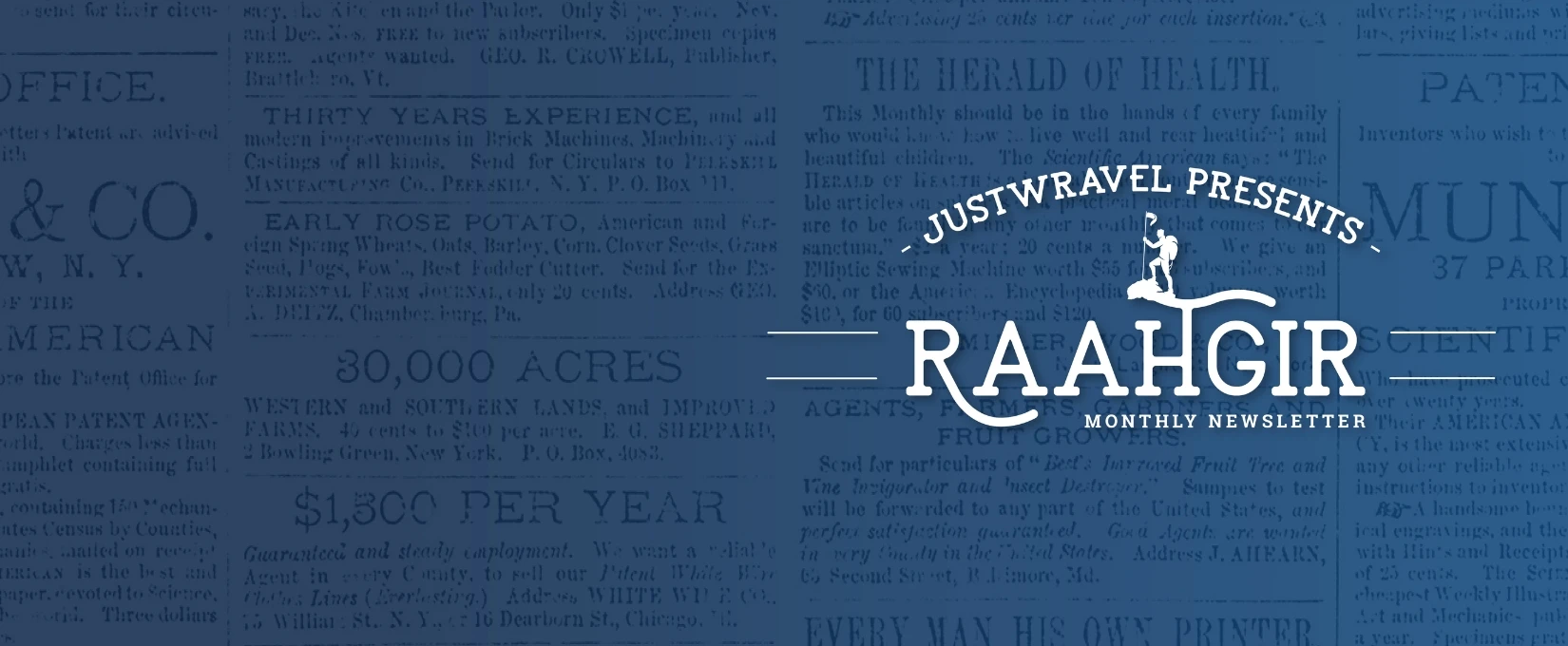
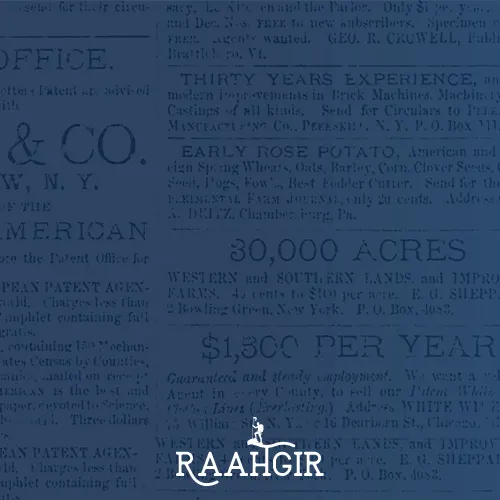
Newsletter
Sign up now!
Be the first one to know all about the Exciting Offers, Travel Updates and more.

B-42, 2nd Floor, Tower- B, The Corenthum, Block A, Sector 62, Noida, Uttar Pradesh 201301
© 2015-2025 JustWravel Pvt. Ltd.

